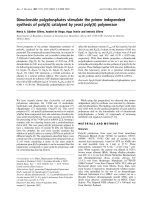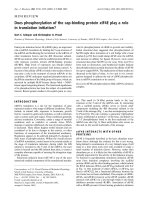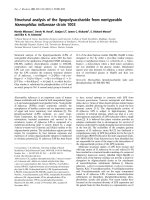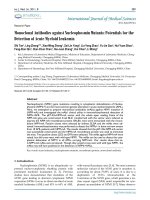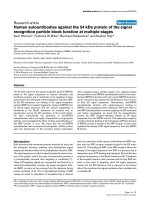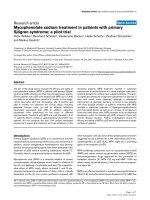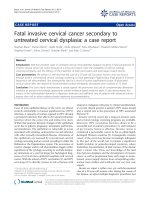Báo cáo y học: " Polyclonal antibody against the DPV UL46M protein can be a diagnostic candidate" pot
Bạn đang xem bản rút gọn của tài liệu. Xem và tải ngay bản đầy đủ của tài liệu tại đây (638.02 KB, 10 trang )
Lu et al. Virology Journal 2010, 7:83
/>Open Access
RESEARCH
BioMed Central
© 2010 Lu et al; licensee BioMed Central Ltd. This is an Open Access article distributed under the terms of the Creative Commons Attri-
bution License ( which permits unrestricted use, distribution, and reproduction in any
medium, provided the original work is properly cited.
Research
Polyclonal antibody against the DPV UL46M
protein can be a diagnostic candidate
Liting Lu
1
, Anchun Cheng*
1,2,3
, Mingshu Wang*
1,2
, Jinfeng Jiang
1
, Dekang Zhu
1,2
, Renyong Jia
2
, Qihui Luo
2
, Fei Liu
2
,
Zhengli Chen
2
, Xiaoyue Chen
1,2,3
and Jinlong Yang
2,4
Abstract
Background: The duck plague virus (DPV) UL46 protein (VP11/12) is a 739-amino acid tegument protein encoded by
the UL46 gene. We analyzed the amino acid sequence of UL46 using bioinformatics tools and defined the main
antigenic domains to be between nucleotides 700-2,220 in the UL46 sequence. This region was designated UL46M.
The DPV UL46 and UL46M genes were both expressed in Escherichia coli Rosetta (DE3) induced by isopropy1-β-
D-
thiogalactopyranoside (IPTG) following polymerase chain reaction (PCR) amplification and subcloning into the
prokaryotic expression vector pET32a(+). The recombinant proteins were purified using a Ni-NTA spin column and
used to generate the polyclonal antibody against UL46 and UL46M in New Zealand white rabbits. The titer was then
tested using enzyme-linked immunosorbent assay (ELISA) and agar diffusion reaction, and the specificity was tested by
western blot analysis. Subsequently, we established Dot-ELISA using the polyclonal antibody and applied it to DPV
detection.
Results: In our study, the DPV UL46M fusion protein, with a relative molecular mass of 79 kDa, was expressed in E. coli
Rosetta (DE3). Expression of the full UL46 gene failed, which was consistent with the results from the bioinformatic
analysis. The expressed product was directly purified using Ni-NTA spin column to prepare the polyclonal antibody
against UL46M. The titer of the anti-UL46M antisera was over 1:819,200 as determined by ELISA and 1:8 by agar
diffusion reaction. Dot-ELISA was used to detect DPV using a 1:60 dilution of anti-UL46M IgG and a 1:5,000 dilution of
horseradish peroxidase (HRP)-labeled goat anti-rabbit IgG.
Conclusions: The anti-UL46M polyclonal antibody reported here specifically identifies DPV, and therefore, it is a
promising diagnostic tool for DPV detection in animals. UL46M and the anti-UL46M antibody can be used for further
clinical examination and research of DPV.
Background
Duck plague virus (DPV) is a pantropic, generalized
infection virus, which can induce an acute, septic, conta-
gious, and lethal disease in ducks, geese, swans, and all
members of the family Anatidae of the order anseri-
formes. The mortality rate of infected adult ducks is up to
90%; therefore, DPV is considered one of the most severe
blights in the waterfowl breeding industry worldwide [1].
The DPV genome is composed of linear, double-
stranded DNA with 64.3% guanine-plus-cytosine con-
tent, which is higher than any other reported avian her-
pesvirus in the subfamily Alphaherpesvirinae [2].
Although DPV was previously grouped in the subfamily
Alphaherpesvirinae, it was classified as an unassigned
virus in the Herpesviridae family according to the Eighth
International Committee of Taxonomy of Viruses [3-5].
However, the molecular characteristics of DPV remain
largely unknown. Following the development of molecu-
lar biology, the research has focused on the molecular
biology of the etiological agent of DPV, especially its
genome atlas and encoding proteins, rather than the gen-
eration and distribution of the virus in its host, the con-
struction and morphogenesis of DPV, and the prevention
and diagnosis of DPV [6-11]. To date, studies on the
genomic organization and nucleotide sequence of DPV
lag behind other members of the Herpesviridae family
* Correspondence:
,
1
Avian Diseases Research Center, College of Veterinary Medicine of Sichuan
Agricultural University, Ya, an, Sichuan, China
1
Avian Diseases Research Center, College of Veterinary Medicine of Sichuan
Agricultural University, Ya, an, Sichuan, China
Full list of author information is available at the end of the article
Lu et al. Virology Journal 2010, 7:83
/>Page 2 of 10
and no reports have been published concerning the DPV
gene UL46. DPV gene transcription can be classified into
3 types: immediate-early (IE), early (E), and late (L) [12].
UL46, which is not essential for virus replication, is a late
transcription gene of the herpesviruses. As the phospho-
rylated product of UL46 translation, the UL46 protein
(VP11/12) plays an important role in enhancing the effi-
ciency of αTIF (VP16)-mediated α gene expression and
initiates α gene transcription through an unknown mech-
anism of action. Generation of an antibody against DPV
UL46 will further research on the function and bionom-
ics of DPV.
Considering that UL46 may be expressed at a low level
or fail to be expressed in a prokaryotic system due to its
long sequence (2,220 bp), we selected peptide fragments
with high antigenicity by predicting the hydrophilicity
and antigenicity of UL46, designated UL46M, in addition
to using the complete UL46 gene. UL46 and UL46M were
expressed in E. coli Rosetta (DE3) by constructing the
prokaryotic recombinant expression plasmids
pET32a(+)/UL46 and pET32a(+)/UL46M. The DPV
UL46M fusion protein had a relative molecular mass of
79 kDa, while expression of the full UL46 gene failed. The
recombinant protein was used to generate the polyclonal
antibody against UL46M in rabbits. ELISA and western
blot identified anti-UL46M antibody with a high titer and
strong specificity, and the antibody was preliminarily
applied in the specific detection of DPV by Dot-ELISA.
The results provide a compact foundation for research on
the function of UL46 and its use in the diagnosis of DPV.
Results
Analysis of hydrophilic and antigenic indices of the DPV
UL46 protein
Generally, the expression of the main antigenic regions of
the protein was prioritized in order of increasing immu-
nogenicity and specificity of the corresponding antibody.
Therefore, we analyzed the hydrophilic and antigenic
indices of UL46 and selected 507 amino acids (site, 233-
739) (Figure 1) as the main antigenic region for expres-
sion to avoid lack of expression, as was the case for the
full UL46 gene.
Gene amplification, cloning, and sequencing
Two regions of DPV, approximately 2,500 bp and 1,500 bp
in UL46 and UL46M, respectively, were amplified by PCR
(Figure 2, lane 1 and lane 2). The PCR products were
digested with BamHI and XhoI restriction enzymes and
the open reading frames (ORFs) were inserted into the
pMD18-T vector to construct the cloning vectors
pMD18-T/UL46 and pMD18-T/UL46M. The recombi-
nant plasmids were then confirmed by DNA sequencing
and restriction digests (Figure 3, lane 2 and lane 1). The
sequencing results showed that there were no nucleotide
errors in the amplified UL46 and UL46M gene fragments
(data not shown).
Expression and purification of recombinant protein
The UL46 and UL46M gene fragments were subcloned
from pMD18-T/UL46 and pMD18-T/UL46M into the
prokaryotic expression vector pET32a(+) using BamHI
and XhoI and were confirmed by restriction enzyme anal-
ysis (Figure 4a, lane 1 and lane 2). The newly formed vec-
tors were designated pET32a(+)/UL46 and pET32a(+)/
UL46M, respectively. To express UL46 and UL46M, the
pET32a(+)/UL46 and pET32a(+)/UL46M plasmids were
transformed into competent E. coli Rosetta (DE3) cells.
However, only a distinct band approximately 79 kDa, cor-
responding to the expected UL46M protein size, was
obtained after a 4-h induction with 0.7 mM isopropy1-β-
D-thiogalactopyranoside (IPTG) (Figure 4b, lane 2 and
lane 3). Expression of the complete UL46 gene was not
successful. Expressed protein was not detected in the
induction of E. coli Rosetta (DE3) cells carrying an empty
pET32a(+) vector (Figure 4b, lane 1) or in the negative
control without induction (Figure 4b, lane 4). The recom-
binant UL46M fusion protein was purified by Ni-NTA
affinity chromatography (Figure 4c, lane 2) based on the
6× His tag present at its N-terminal. The density of the
UL46M fusion protein was 3.09 mg/mL by the Bradford
method.
Verification of the character of the polyclonal antibody
Ђ Detection of the antiserum titer by agar diffusion reac-
tion. The highest titer of the agar diffusion reaction of the
anti-UL46M antiserum from the 6 rabbits showed that
the largest positive dilution multiple was 1:8 (Figure 4d).
The highest titer of anti-UL46M antibodies from the 6
rabbits as determined by ELISA was 1:819,200 (Table 1).
The pre-immune serum was used as a negative control. ?
Analysis of antibody specificity by western blot. The
result revealed that the anti-UL46M rabbit IgG antibody
recognized the purified recombinant protein, showing a
specific signal at the expected size (79 kDa) (Figure 4e,
lane 2). No positive signal was observed when using the
negative control sera (date not shown), indicating that the
recombinant protein induced an immunological response
and that the antisera had a high level of specificity. This
suggests that the antiserum is suitable for DPV detection
in clinical diagnoses. Additionally, these results were sup-
ported by the results of the western blot with anti-DPV
IgG and the UL46M protein (Figure 4e, lane 1).
Detection of DPV by Dot-ELISA
The preliminary application of the polyclonal antibody
against DPV UL46M was in the detection of DPV by Dot-
ELISA. Thus, the samples were prepared on a nitrocellu-
lose (NC) membrane and the anti-UL46M IgG and HRP-
labeled goat anti-rabbit IgG antibodies were used for
Lu et al. Virology Journal 2010, 7:83
/>Page 3 of 10
DPV detection. The square matrix test determined that
the suitable dilution of anti-UL46M IgG was 1:60 and that
of HRP-labeled goat anti-rabbit IgG were 1:5,000. Dot-
ELISA showed a stronger positive signal for DPV in the
liver sample and was negative with duck hepatitis virus-1
(DHV-1), E. coli (O1), Salmonella enteritidis (SE), Rie-
merella anatipestifer (RA), Pasteurella multocida, and
normal saline, as shown in Figure 5a.
Discussion
The UL46 gene is not evolutionarily conserved among
the different Herpesvirus subfamilies. UL46 is only con-
served in alphaherpesviruses such as Herpes simplex
virus type 1 (HSV-1) and is not present in beta- and gam-
maherpesviruses such as human cytomegalovirus
(HCMV) and Epstein-Barr virus (EBV), respectively (13-
15). Although UL46 is not essential for virus replication,
the formation of plaque bacteriophage can be effected in
the absence of UL46 [16,17]. VP11/12, the phosphory-
lated product of the translated UL46 gene, plays an
important role in enhancing the efficiency of αTIF
(VP16)-mediated α gene expression and in initiating α
gene transcription [18]. Therefore, the research con-
ducted here on DPV UL46 and corresponding antibody
characteristics revealed significant theoretical and practi-
cal value for understanding the molecular mechanism of
DPV.
For the preparation of the anti-UL46 rabbit antibody, 2
factors had to be considered. First, the collecting of main
antigens was the key for a gene, especially for the longer
fragment, and the stronger hydrophilic and antigenic
regions were important for maintaining the immunoreac-
tivity of the antigen. Thus, we selected the more hydro-
philic and antigenic regions of the DPV UL46 gene,
namely, the 507 amino acid N-terminal (233-739 site), as
the main UL46 antigen in addition to the complete UL46
gene to ensure greater specificity and a higher titer of the
corresponding antibody. Second, it was difficult to
extract UL46 from infected cells and the relative molecu-
lar weight of UL46 was only 81.8 kDa. Additionally, the
weaker antigenicity of UL46 may not elicit a stronger
immune response in rabbits that were already immu-
nized. Therefore, the prokaryotic expression vector
pET32a(+) was chosen to express the UL46M fusion pro-
teins in E. coli.
In our study, the E. coli host cells BL21 (DE3), BL21
(DE3) plysS, and Rosetta were all used to express UL46
and UL46M. The results identified that the expression
level of UL46M was similar among the 3 host cells, and
the full UL46 gene failed to express. Temperature was a
major influence on the expression level, compared with
inducing time and IPTG density. In addition, the recom-
binant protein was expressed within inclusion bodies.
Since the inclusion body did not possess biological activ-
ity, the protein was redissolved and renatured prior to
inoculation. His-tagged UL46M was expressed using
pET32a(+), which was convenient for recombinant pro-
tein purification. In addition, the His tag did not influ-
ence the structure or function of UL46M due to its small
molecular weight, and even inclusion bodies were benefi-
cial in increasing the stability of product by preventing
proteolytic degradation of the protein.
The Dot-ELISA has become a new addition to the diag-
nostic arsenal against microbes, contagious and parasitic
diseases, because it is easy to use, is economical, requires
small antigen dosage, and the results are easy to interpret.
Therefore, we established the Dot-ELISA for DPV detec-
tion using the anti-DPV UL46M polyclonal antibody. The
result revealed polyclonal antibody specificity for DPV;
thus, we concluded that this anti-UL46M antibody could
be used to diagnose DPV.
Figure 1 Analysis of hydrophilicity and antigenic index of DPV UL46 protein. The hydrophilicity and antigenic index of DPV UL46 protein were
analyzed by DNAstar6.0. Then the main antigen regions UL46M was selected on the basis of the analysis result and was expressed with the complete
UL46 gene.
Lu et al. Virology Journal 2010, 7:83
/>Page 4 of 10
We employed a double wavelength (450 nm/630 nm) to
detect the optical density of samples in order to decrease
light interference caused by scratches or fingerprints on
the 96-well microtiter plate. Considering that antigen
purity was not 100% and that the polyclonal antibody was
based on many epitopes, the purified IgG was used to
avoid nonspecific binding during titer quantification,
antibody specificity determination, and application of
Dot-ELISA. The results revealed that the anti-UL46M
rabbit antibody prepared in our study was of high titer
and specificity.
Conclusions
In conclusion, the preparation of the specific anti-UL46M
rabbit antibody established a foundation for further
research on the biological activity and molecular mecha-
nism of UL46. This can be extended to the qualitative and
quantitative analysis of the UL46 protein using immuno-
fluorescent and immunochemical techniques, thus pro-
viding useful tools for studying the structure and
function.
Methods
Analysis of hydrophilic and antigenic indices of DPV
UL46protein
The NCBI BLASTN and ORF Finder servers were used to
find an ORF. Then, the hydrophilic and antigenic indices
of DPV UL46 were analyzed using the DNAstar6.0 soft-
ware (DNASTAR Inc., USA), by using the predicted
Figure 2 PCR products of the fragments of DPV UL46M and
UL46M gene. Lane 1, PCR product of DPV UL46; Lane M, DNA marker;
Lane 2, PCR product of DPV UL46M.
Figure 3 DPV UL46 and UL46M gene encoding DNA sequences
were cloned into pMD18-T cloning vector. The recombinant plas-
mids were digested with two restriction enzymes. Lane 1, BamHI and
XhoI generating two restriction fragments of UL46M; Lane M, DNA
marker; Lane 2, BamHI and XhoI generating two restriction fragments
of UL46.
Lu et al. Virology Journal 2010, 7:83
/>Page 5 of 10
Figure 4 A. DPV UL46 and UL46M gene encoding DNA sequences were cloned into pET32a (+) procaryotic expression vector. The recombi-
nant plasmids were digested with two restriction enzymes. Lane 1, BamHI and XhoI generating two restriction fragments of UL46; Lane M, DNA marker;
Lane 2, BamHI and XhoI generating two restriction fragments of UL46M. B. Induction of the 6× His-tagged UL46M fusion protein in E. coli plasmid
pET32-a (+)/UL46M was transformed into bacteria. Bacteria were grown in the absence (lane 4) or the presence (lane2 and lane 3) of IPTG. Induced
pET32-a (+) was as control (lane 1). Molecular mass marker (in kDa) were shown to the right (lane 5). C. The recombinant UL46M fusion protein was
purified by Ni-NTA affinity chromatography. Lane 1, unpurified recombinant UL46M fusion protein; Lane 2, purified recombinant UL46M fusion pro-
tein; Lane M, protein marker. D. Detection result of the antisera titer by agar diffusion reaction. The result of the agar diffusion reaction of the anti-
UL46M antiserum showed the largest dilution multiple of the positivation was 1:8. 1-6.1, 2, 4, 8, 16, 32-fold diluted antisera; 0. DPV. E. Analysis of the
antibody specificity by western blot The result revealed that the purified recombinant protein was recognized by the anti-UL46M rabbit IgG and
showed a specific signal at the expected size (79 kDa). No positive signal was observed when using the negative control sera (date not shown). Lane
1, western blot of anti-DPV IgG with the UL46M protein; Lane 2, western blot of anti-DPV UL46M IgG with the UL46M protein; Lane M, prestained pro-
tein marker.
A B
C
D
E
Lu et al. Virology Journal 2010, 7:83
/>Page 6 of 10
amino acid sequence of the complete ORF to obtain the
main antigenic domain of UL46 (UL46M).
Preparation of DPV DNA
DPV was propagated in Duck Embryo Fibroblasts (DEFs)
that were cultured in Minimum Essential Medium
(MEM) (Invitrogen, Carlsbad, CA) containing 10% fetal
bovine serum (FNS) (Invitrogen, Carlsbad, CA) and 1-2%
penicillin and streptomycin at 37°C. After virus infection,
MEM supplements with 2-3% FBS and 1-2% penicillin
and streptomycin were used. The virus particles were
harvested when the cytopathic effect reached 75%. Cell
lysates containing DPV were subjected to 3 freeze-thaw
cycles and were then stored at -70°C until use. The
extraction of DPV DNA was performed as described pre-
viously [19].
PCR amplification of the UL46 and UL46M genes
We identified and isolated the major antigenic domains of
UL46, which were designated as UL46M, in conjunction
with the full-length UL46 gene. Based on the constructed
DPV CHv-strain genomic library, the primer sequences
for PCR amplification of the DPV UL46 and UL46M
genes were synthesized by TaKaRa (Dalian, China) as fol-
lows: (A) the full UL46 gene: forward primer (P1) 5'-
GGATCCACGGTGATGTCGTCCAGG-3' and reverse
primer (P2) 5'-CTCGAGGCGTCTTTGGTTTGTCG-
TAA-3', and (B) the UL46M gene: forward primer (P1) 5'-
GGATCCCCGCTGGATCTTATGGTT-3' and reverse
primer (P2) 5'-CTCGAGTTATTTCCCAAAT-
GACAGTCT-3' [20]. The BamHI and XhoI sites that
were used to clone the PCR fragment are bolded in the
primer sequences. The primers were dissolved in ultra-
pure water to a concentration of 20 pmol/μL. The PCR
amplifications contained 12.5 μL of 2× Taq PCR Master-
Mix (TianGen, Beijing, China), 1 μL (20 pmol/μL) of each
primer, 1 μL of template (10 ng/μL), and ultrapure water
to a total reaction volume of 25 μL. The PCR cycle
parameters were as follows: (A) the complete UL46 gene:
5 min at 95°C and 30 cycles of 1 min at 94°C, 1 min at
59°C, 2 min 40 s at 72°C, and a final extension time of 10
min at 70°C; (B) the UL46M gene: 5 min at 95°C and 30
cycles of 1 min at 94°C, 1 min at 56°C, 1 min 50 s at 72°C,
and a final extension time of 10 min at 70°C. The ampli-
fied products were visualized by gel electrophoresis (10 g/
L agarose gel containing 5 μL/100 mL goldview).
Construction and identification of the cloning plasmids
pMD18-T/UL46 and pMD18-T/UL46M
The purified PCR products were digested with restriction
enzymes BamHI and XhoI, purified, and ligated into the
correspondingly digested cloning vector pMD18-T at
16°C overnight using DNA Ligation Mix. The subse-
quently generated recombinant cloning plasmids were
named pMD18-T/UL46 and pMD18-T/UL46M, respec-
tively (e.g., UL46, Figure 5b). The recombinant plasmids
were transformed into E. coli DH5α cells, and the trans-
formants were cultured at 37°C on Luria-Bertani (LB)
solid medium (1.0% sodium chloride, 1.0% tryptone, 0.5%
yeast extract, and 1.5% agars) for 16 h. The masculine
clones were collected and grown in liquid LB medium
(1.0% sodium chloride, 1.0% tryptone, 0.5% yeast extract,
and 100 μg/mL ampicillin) at 37°C for 12 h. The recombi-
nant plasmids were verified by PCR and designation
under the above condition. Each clone was then selected
and sent to TaKaRa for sequencing. Then we performed
the nucleotide homology comparison with the public
sequence (GenBank: EU195108
) available in NCBI Gene-
Bank using DNAMAN and blast tools.
Construction and identification of the recombinants
pET32a(+)/UL46 and pET32a(+)/UL46M
After confirmation of the sequencing results, pMD18-T/
UL46 and pMD18-T/UL46M plasmids were digested
with BamHI and XhoI and purified using a TIANprep
Mini Plasmid Kit (TianGen). We then cloned the respec-
tive fragments into the 6× His-tagged prokaryotic expres-
sion vector pET32a(+) at the BamHI and XhoI sites and
designated them as expression vector pET32a(+)/UL46
and pET32a(+)/UL46M (e.g., UL46, Figure 5c) [21]. The
selected positive colonies were identified by PCR and
designated under the above condition.
Table 1: The results of ELISA (OD
450 nm/630 nm
)
Dilution proportion Ђ Antisera ? Normal sera Ђ/?
1:400 1.721 0.428 4.021
1:409600 0.688 0.102 6.745
1:819200 0.441 0.087 5.069
1:1638400 0.302(<0.4) 0.053
The values were the mean results of three parallel experiments, when Ђ/? ≥2.1 and Ђ ≥ 0.4, the ELISA result was positive. The pre-innune sera
was the negative control.
Lu et al. Virology Journal 2010, 7:83
/>Page 7 of 10
Figure 5 A. Detection of DPV by Dot-ELISA. The preliminary application of the polyclonal antibody against DPV UL46M was the establishment of
Dot-ELISA to detect DPV. The result showed stronger positive signal with the liver sample of DPV, while negative with DHV-1, E. coli (O1), SE, RA, P.
multocida and normal saline. 1. DPV, 2. DHV-1, 3. E. coli (O1), 4. SE, 5. RA, 6. P. multocida, 7. normal saline (negative). B. Schematic diagram of the UL46
ORF cloned into the pMD18-T cloning vector. The fragment of UL46 digested with BamHI and XhoI was cloned into cloning vector pMD18-T at 16°C
overnight using DNA Ligation Mix to generate recombinant cloning plasmid named pMD18-T/UL46. C. Construction of the recombinant expression
plasmid pET32a (+)/UL46. The fragment of UL46 digested with BamHI and XhoI from pMD18-T/UL46 was cloned into a 6× His-tagged prokaryotic ex-
pression vector pET32a(+) at BamHI and Xho sites and designated it as expression vector pET32a(+)/UL46.
A
B
C
Lu et al. Virology Journal 2010, 7:83
/>Page 8 of 10
Prokaryotic expression of the DPV UL46 and UL46M genes
E. coli Rosetta (DE3) cells transformed with the prokary-
otic expression plasmids pET32a/UL46 and pET32a/
UL46M were cultured in presence of ampicillin (100 μg/
mL) in LB medium with vigorous shaking at 37°C until an
A
600
of 0.4-0.6. The expression of the recombinant fusion
proteins was induced by addition of 0.7 mM/L IPTG and
further shaken at 37°C for 4 h. After induction, the cells
were harvested by centrifugation at 6,000 rpm for 10 min
at 4°C and lysed in 5× sodium dodecyl sulfate-polyacryl-
amide gel electrophoresis (SDS-PAGE) loading buffer
(0.313 M Tris-HCl (pH 6.8), 50% glycerol, 10% SDS, and
0.05% bromophenol blue with 100 mM DTT). The unin-
duced control and the vector control cultures were ana-
lyzed in parallel.
Purification of the recombinant proteins by Ni-NTA
As described above, 4 g of wet weight cells from a 1-L cul-
ture was harvested by centrifugation at 6,000 rpm for 10
min, and the pellet was suspended in 20 mL lysis buffer
(20 mM Tris-HCl buffer (pH 8.0) containing 100 mM
NaCl, 1.0 mM phenylmethyl sulfonylfluoride (PMSF),
and 1.0 mg/mL lysozyme). The suspension was incubated
for 30 min at 4°C with stirring and was then pulse-soni-
cated on ice (30 s working and 30 s resting on ice; Vibra-
cell VCX 600 sonicator; 600 watt max, Sonics & Materials
Inc., USA) until the sample was clear. Sonication was per-
formed to lyse cells and release intracellular protein. The
resulting cell lysate was centrifuged at 12,000 rpm for 30
min (AM50.14, Thermo electron Co.). The collected pel-
let was dissolved in deionized water and analyzed by 12%
SDS-PAGE. The recombinant protein was purified using
the Ni-NTA Spin Column kit, according to the manufac-
turer's instructions. The density of the recombinant pro-
tein was detected using the Bradford method and stored
at -80°C until use [22].
Production of the rabbit polyclonal antibodies
Six male New Zealand white rabbits were immunized
using purified recombinant DPV UL46M protein accord-
ing to Hu et al. [23]. One milliliter of pre-immune sera
was collected from the ear margin of each rabbit as the
negative control. Each rabbit was injected with 0.5 mg
antigen mixed with complete Freund's adjuvant in a 1:1
ratio on the back and proximal limbs. After 1 week, the
rabbits were subsequently injected 3 times with the anti-
gen (1.0 mg/rabbit) mixed with incomplete Freund's adju-
vant at intervals of 1 week. Two weeks after the fourth
injection, the rabbits were sacrificed and the antisera was
harvested from the arteriae carotis and stored at -80°C
until use.
Purification of the antisera
The rabbit IgG fraction was precipitated from the har-
vested rabbit polyclonal antisera in saturated ammonium
sulfate according to Walker et al. [24]. Then, the IgG frac-
tion was purified by High-Q anion-exchange chromatog-
raphy following the manufacturer's instructions using a
DEAE-Sepharose column (Bio-Rad) and was analyzed on
a 12% SDS-PAGE gel.
Identification of the polyclonal antibody
Ђ Detection of the antisera titer by agar diffusion reac-
tion. One gram of agar was dissolved in buffered saline
prepared by the addition of 0.85 g of sodium chloride to
100 mL of distilled water. The mixture was heated, cooled
down to 55°C, and poured into the plates to a thickness of
2 mm. The agar was then perforated with 3 mm-diameter
holes that held approximately 100 μL of solution. Thirty
microliters of 1-, 2-, 4-, 8-, 16-, and 32-fold diluted anti-
sera was added into the peripheral apertures and DPV
was added into the central aperture. The plate was dif-
fused at 37°C for 24 h. The largest dilution multiple of the
sediment band identified the antibody titer. ? Detection
of the titer of anti-UL46M rabbit antibody by ELISA. A
96-well microtiter plate (Nunc, Denmark) was coated
with 100 μL (0.01 mg/L) purified DPV in sodium bicar-
bonate buffer (pH 9.6) and incubated at 37°C for 1 h and
then at 4°C overnight. The plate was blocked with 100 μL
of blocking solution (1% BSA in PBS) for 1 h at 37°C and
washed 3 times with PBST (0.05% Tween 20 in PBS). Sub-
sequently, 100 μL of a 2 multiple (1:400 to 1:819,200) dilu-
tion of purified anti-UL46M IgG was added and
incubated at 37°C for 1 h. The plate was washed and incu-
bated for 1 h at 37°C with 100 μL of a 1:5,000 dilution of
anti-HRP-labeled goat anti-rabbit IgG diluted, washed
again and detected with 100 μL of 3,3',5,5'-tetramethyl-
benzidine (TMB)-H
2
O
2
for 30 min at room temperature.
The reaction was stopped by the addition of 50 μL of 30%
H
2
SO
4
. 20 min later, and the optical density (OD) was
determined at 450 nm/630 nm double wavelength using a
Bio-Rad model 860 plate reader (Bio-Rad, CA, USA). The
normal rabbit sera and PBST were used in parallel as the
negative control and blank, respectively. When the OD
value of the anti-sera was ≥0.4 and the ratio with normal
sera was ≥2.1, the result was positive. The largest positive
dilution multiple was the antisera titer. ? Analysis of anti-
body specificity by western blot. To characterize the
specificity of the antibody, western bolt analysis was per-
formed according to standard procedure [19]. Then, the
DPV UL46M protein was separated on a 12% SDS-PAGE
gel. Following electrophoresis, the gel was immersed in
transfer buffer (0.24% Tris-HCl, 1.153% glycine, and 15%
methanol, pH 8.8) and electro-blotted onto polyvi-
nylidene difluoride (PVDF) membrane at 100 V for 1.5 h.
The membrane was incubated in blocking buffer (5% BSA
in the PBS buffer) for 1 h at 37°C. The membrane was
incubated with purified anti-UL46M IgG (1:200 dilution)
overnight at 4°C after three washes with PBST buffer
(0.2% Tween 20 in PBS, pH 7.4). The membranes were
Lu et al. Virology Journal 2010, 7:83
/>Page 9 of 10
incubated with HRP-labeled goat anti-rabbit IgG (Bod-
ter) in a 1:5,000 dilution for 1 h at 37°C. The membrane
was developed with DAB substrate buffer following PBST
washes and terminated by washing in distilled water.
Western blot of anti-DPV IgG for UL46M was performed
accordingly.
Detection of DPV by Dot-ELISA
Ђ Animal test. One day old ducks were infected with one
of DPV, duck Hepatitis Virus type 1 (DHV-1), E. coli (O1),
SE, RA, and P. multocida, and the livers from the dead
ducks were obtained as the antigen species, while normal
saline was used as the negative control in parallel. ? Sam-
ple preparation. Aseptic PBS was added in a 1/3 (w/v)
ratio to the samples, which were then grinded into homo-
genate and centrifuged at 8,000 rpm for 10 min at 4°C
after freeze-thawing 3 times at -20°C. The supernatant
was collected as the antigen species for detection by Dot-
ELISA, and detection using negative and blank controls
was conducted in parallel. ? Detection of Dot-ELISA. The
NC membrane was cut to optimal size and the sample
spot was marked using a pencil. The membrane was then
saturated in ddH
2
O for 10 min and dried at room temper-
ature. Five microliters of treated samples, at dilutions
greater than 1:100, were loaded onto the NC membrane
at the previously marked locations (spotting a small
amount of sample and drying at room temperature each
time), followed by drying the NC membrane completely
at room temperature. The NC membrane was blocked for
1 h at 37°C using blocking solution (1% BSA in PBS) and
washed 3 times (5 min each) with PBST (0.05% Tween 20
in PBS). Subsequently, the membrane was incubated with
a 1:60 dilution of rabbit anti-UL46M IgG with 0.1% BSA
in PBS overnight at 4°C, and washed the following day.
The membrane was further incubated for 1 h at 37°C with
anti-HRP-labeled goat anti-rabbit IgG diluted 1:5,000 in
PBS and developed using a DAB substrate buffer at room
temperature until an amethyst signal was observed.
Thorough washing in ddH
2
O terminated the reaction.
The negative and blank controls were conducted in paral-
lel. Distinct spots with consistent structures indicated a
positive result, while fuzzy spots with structural anoma-
lies or the lack of a spot indicated a negative result.
Competing interests
The authors declare that they have no competing interests.
Authors' contributions
LL carried out most of the experiments and wrote the manuscript. AC and MW
critically revised the manuscript and the experiment design. JJ, DZ, RJ, QL, FL,
ZC, XC and JY helped with the experiment. All of the authors read and
approved the final version of the manuscript.
Acknowledgements
The research was supported by Changjiang Scholars and Innovative Research
Team in University (PCSIRT0848) and the earmarked fund for Modern Agro-
industry Technology Research System (nycytx-45-12).
Author Details
1
Avian Diseases Research Center, College of Veterinary Medicine of Sichuan
Agricultural University, Ya, an, Sichuan, China,
2
Key Laboratory of Animal
Diseases and Human Health of Sichuan Province, Ya, an, Sichuan, China,
3
Epizootic Diseases Institute of Sichuan Agricultural University, Ya, an, Sichuan,
625014, China and
4
Chongqing Academy of Animal Science, Chongqing,
402460, Chongqing China
References
1. Sandhu TS, Shawky SA: Duck virus enteritis (duck plague). In Diseases of
Poultry Edited by: Saif YM, Barnes HJ, Glisson, JR. Ames: Iowa State
University Press; 2003:354-363.
2. Gardner R, Wilkerson J, Johnson JC: Molecular characterization of the
DNA of Anatid herpesvirus 1. Intervirology 1993, 36:99-112.
3. Kaleta EF: Herpesviruses of birds-a review. Avian Pathol 1990,
19:193-211.
4. Shawky S, Schta KA: Latency sites and reactivation of duck enteritis
virus. Avian Dis 2002, 46:308-313.
5. Fauquet CM, Fauquet C, Mayo MA, Maniloff J: Virus Taxonomy: Eighth
Report of the International Committee on Taxonomy of Viruses. San
Diego, Elsevier; 2005.
6. Cheng AC, Wang MS, Liu F, Song Y, Yuan GP, Han XY, Xu C, Liao YH, Wen
M, Zhou WG, Jia RY: Distribution and excretion of duck plague virus
attenuated Chv strain in vaccinated ducklings. Chinese Journal of
Veterinary Science 2005, 25:231-233. (in Chinese)
7. Qi XF, Yang XY, Cheng AC, Wang MS, Zhu DK, Jia RY: Quantitative analysis
of virulent duck enteritis virus loads in experimentally infected
ducklings. Avian Dis 2008, 52:338-344.
8. Yuan GP, Cheng AC, Wang MS, Liu F, Han XY, Liao YH, Xu C: Electron
microscopic studies of the morphogenesis of duck enteritis virus.
Avian Dis 2005, 49:50-55.
9. Jia RY, Cheng AC, Wang MS, Guo YF, Wen M, Xu C, Yuan GP, Zhou WG,
Zhou Y, Chen XY: Studies of ultrastructure of duck enteritis virus CHv
virulent strain. Chinese Journal of Virology 2007, 23:202-205. (in Chinese)
10. Yuan GP, Cheng AC, Wang MS, Zhou Y, Liu F, Han XY, Guo YF, Liao YH, Xu
C, Wen M, Jia RY, Zhou WG, Chen XY: Electron microscopic studies on
morphology and morphogenesis of duck enteritis virus in ducks
infected with DEV virulent strain experimentally. Acta Veterinaria et
Zootechnica Sinica 2005, 36:486-491. (in Chinese)
11. Hansen WR, Nashold SW, Docherty DE, Brown SE, Knudson DL: Diagnosis
of duck plague in waterfowl by polymerase chain reaction.
Avian Dis
2000, 44:266-274.
12. Honess RW, Roizman B: Regulation of herpesvirus macromolecular
synthesis.I. Cascade regulation of the synthesis of there groups of viral
proteins. Journal of Virology 1974, 14:8.
13. Mcgeoch DJ, Dalrymple MA, Davison AJ, Dolan A, Frame MC, McNab D,
Perry LJ, Scott JE, Taylor P: The complete DNA sequence of the unique
long region in the genome of herpes simplex virus type 1. J Gen Virol
1988, 69:1531-1574.
14. Chee MS, Bankier AT, Beck S, Bohni R, Brown CM, Cerny R, Horsnell T,
Hutchison CA, Kouzarides T, Martignetti JA: Analysis of the protein
coding content of the sequence of human cytomegalovirus strain
AD169. Curr Top Microbiol Immunol 1990, 154:125-169.
15. Baer R, Bankier AT, Biggin MD, Deininger PL, Farrell PJ, Gibson TJ, Hatfull G,
Hudson GS, Satchwell SC, Seguin C, Tuffnell PS, Barrell BG: DNA sequence
and expression of the B95-8 Epstein-Barr virus genome. Nature 1984,
310:207-211.
16. Fuchs W, Granzow H, Mettenleiter TC: A Pseudorabies Virus
Recombinant Simultaneously Lacking the Major Tegument Proteins
Encoded by the UL46, UL47, UL48, and UL49 Genes Is Viable in
Cultured Cells. J Virol 2003, 77:12891-12900.
17. Zhang YZ, Mcknight JL: Herpes simplex virus type 1 UL46 and UL47
deletion mutants lack VP11 and VP12 or VP13 and VP14, respectively,
and exhibit altered viral thymidine kinase expression. J Virol 1993,
67:1482-1492.
18. Kato K, Daikoku T, Goshima F, Kume H, Yamaki K, Nishiyama Y: Synthesis,
subcellular localization and VP16 interaction of the herpes simplex
virus type 2 UL46 gene product. Arch Virol 2000, 14:2149-2162.
Received: 3 February 2010 Accepted: 29 April 2010
Published: 29 April 2010
This artic le is available fro m: http://www.v irologyj.com/co ntent/7/1/83© 2010 Lu et al; licensee BioMed Central Ltd. This is an Open Access article distributed under the terms of the Creative Commons Attribution License ( which permits unrestricted use, distribution, and reproduction in any medium, provided the original work is properly cited.Virology Journal 2010, 7:83
Lu et al. Virology Journal 2010, 7:83
/>Page 10 of 10
19. Sambrook J, Russell DW: Molecular Cloning: A Laboratory Manual 3rd
edition. Edited by: Huang Pei-tang, Wang Jia-xi, Zhu Hou-chu, et al.
Beijing: Science Press; 2003:27-30. 96-99. (in Chinese)
20. Cheng AC, Wang MS, Wen M, Zhou WG, Guo YF, Jia RY, Xu C, Yuan GP, Liu
YC: Construction of duck enteritis virus gene libraries and discovery,
cloning and identification of viral nucleocapsid protein gene. High
Technol Lett 2006, 16:948-953.
21. Cai MS, Cheng AC, Wang MS, Zhao LC, Zhu DK, Luo QH, Liu F, Chen XY:
His-Tagged UL46 protein of duck plague virus: expression, purification
and production of polyclonal antibody. intervirology 2009, 52:141-151.
22. Bradford M: A rapid and sensitive method for the quantitation of
microgram quantities of protein utilizing the principle of protein
utilizing the principle of protein-dye binding. Analytical Biochemistry
1976, 72:248-254.
23. Hu YX, Guo JY, Shen L, Chen Y, Zhang ZC, Zhang YL: Get effective
polyclonal antisera in one month. Cell res 2002, 12:157-160.
24. Walker JM: Purification of IgG by precipitation with sodium sulfate or
ammonium sulphate. In The protein protocols handbook second edition.
Humana press . 101385/1-59259-169-8: 983-984 (copyright 2002)
doi: 10.1186/1743-422X-7-83
Cite this article as: Lu et al., Polyclonal antibody against the DPV UL46M pro-
tein can be a diagnostic candidate Virology Journal 2010, 7:83
